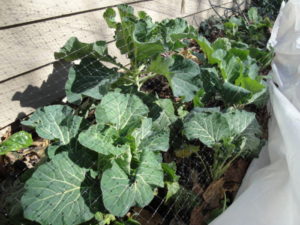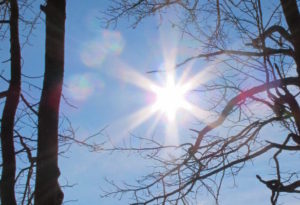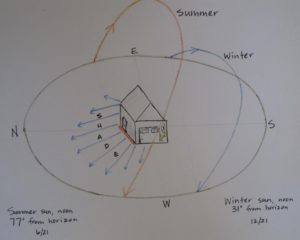Before you start digging, you must first decide where the garden will be located. Many factors should be considered, and the most important one is exposure to the sun. Just outside the back door seems like the logical choice. It’s always sunny next to the patio for summer barbecues. And it’s close to the kitchen and to the water faucet.
Yes, But Is It Sunny In the Winter?
That spot is fine, if you’re interested in growing main-season vegetables. But later this year, you’d like to venture into the world of Asian greens and other cool-season vegetables. First you will need to know if it will be sunny in the winter. The garden patch gets full sun in June, but it might be entirely shaded by the house in December!
The Sun’s Path
The sun’s path and the shadows cast by buildings and trees vary greatly from season to season and from one latitude to another. On the shortest day of the year (the first day of winter) where I live in North Carolina, the sun rises only 31 degrees above the southern horizon. At that time, it rises and sets south of the true east-west axis. On the longest day of the year (the first day of summer), the sun is 77 degrees above the horizon, and rises and sets north of the east-west axis.
A north-facing back yard might be shaded by the house in winter due to low, slanting rays of January sun. In this case, move the proposed garden site farther away from the house. You will be able to enjoy both summer and cool-season crops. Your efforts can be divided among a few plots around the property. Plant each one with the crops that are best suited there at a particular time of the year.
Deciduous trees, such as maple, oak, and cherry, drop their leaves in autumn. Most cool-season greens will receive enough light as it filters through the stems and branches of trees. In our garden (photo, below), you can see shadows cast by twigs and branches from trees growing on the berm to the south. But, by the time the trees leaf out in spring, the sun is almost directly overhead. Tomatoes and peppers planted then will get enough sun, but as the tree canopy expands, the garden will be less sunny in the winter. Time for a bigger garden…elsewhere!
Is Your Garden Sunny In the Winter?

Cool season vegetables and greens. Plastic covers garden on very cold nights, and netting protects plants from deer.
In regions of the country with moderate winter temperatures, greens can be harvested through the season if the garden gets at least 5 hours of direct sun per day. Leafy greens (spinach, kale, mustard, tatsoi, Swiss chard, lettuce, and many others) will grow fairly well with slightly less sun than that required by head-forming vegetables, such as cabbage, broccoli, Brussels sprouts, and cauliflower.
But exposure to the sun for a longer period of time in winter is always best. The plants grow faster and stronger, and the soil absorbs more heat from the sun during the daytime. More heat prevents the soil from freezing deeply.
Using protective cold frames over the garden moderates severely cold temperatures by trapping the sun’s heat. Warmth is stored in the soil, and released to the plants during the night. Some crops, such as kale, collards, broccoli, parsley, arugula, and cilantro, tolerate cold weather. They often survive without any protection, in the southern half of the country, until they go to flower (or into the stockpot) in spring!
I’ll talk more about cold frames and other protective devices in future posts, and you might have guessed that I’m a fan. On sunny days, of course, cold frames have to be vented in order to release hot air and to get fresh air (with carbon dioxide) in.
Locate the Garden
So, once you decide which crops you want to grow—whether they’re warm-season or cool-season, or both—you can start by observing the path of the sun. Get your young math genius out there, with sticks and string, a level, a compass, and a protractor. Find how the sun and shadows track across the sky at different times of the year. Vegetable gardening could become a great family pastime!
Something else that could influence the location of the garden is the existence of underground conduit, utilities, and cables. Call your local officials (8-1-1) to have the utilities marked before digging anywhere. Tree roots also are a hassle. Guess which one wins if there are maple tree roots infiltrating the vegetable garden.

Free-Photos / Pixabay. Stone circles built thousands of years ago were ceremonial and helped indicate when crops could be planted.

